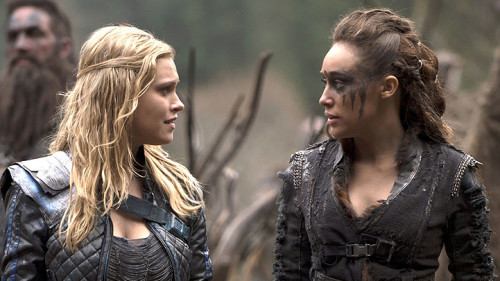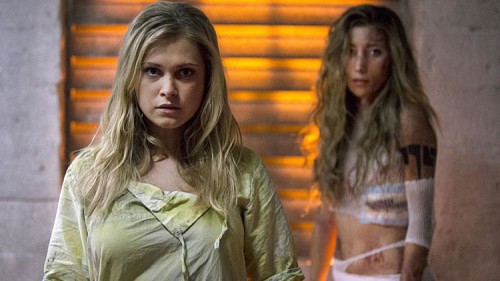This guest post by Rowan Ellis appears as part of our theme week on Sex Positivity.
This article contains spoilers for the first two seasons of The 100 … be warned!
On the surface, it might seem like we live in a sex positive society already, I mean, I just wrote an article about Channing Tatum’s intimidatingly chilled torso for this very website. We hear things like “sex sells” all the time, meaning it’s clearly viewed as positive for our economy if nothing else. But the tiniest scratch below that oiled up muscly surface shows something more complex and gendered. Women’s sexualities and sex lives are viewed in turn as both precious fortresses and exploitable commodities, by a world which can’t quite make up its mind whether it wants to protect us or fuck us. But then men and boys are being taught not to respect either a “weak” woman who needs protecting, or a “slutty” woman who wants to be fucked. So it came as a ridiculously pleasant surprise to see the portrayal of sex and sexuality in the CW’s teen dystopian show The 100.
The 100 is one of those shows that snuck up on me; I watched the pilot when it first came out, and promptly dismissed it as an OK series that I might try again if I got bored and it ended up on Netflix. It’s the story of obligatory-CW-beautiful Clarke (Eliza Taylor) and 99 other teenage prisoners who lived on “The Ark,” a collection of space stations which houses all that is left of the human race, floating above the Earth. I say “lived,” past tense, because pretty much as soon as the show opens all 100 of them are blasted down onto the surface of our messed up planet to see if it’s survivable. One-hundred delinquent teenagers alone on a potentially deadly planet. What could go wrong? Honestly, I only gave the show a real chance after Tumblr excitedly informed me that the lead character wasn’t entirely straight, and it came under the radar as a show with increasingly great representation. So I gave it another chance, and by the time half a season had gone by, it was clear they were building a series that wasn’t afraid to give the middle finger to easy outs and happy endings. And yet, none of those difficult choices or moral and physical suffering were linked to the characters’ sex lives.
Although we like to talk about characters as if they were independent entities, it is the writers who choose character’s choices and the consequences of their actions; traditionally morality plays and novels had marriages to reward the good and death to reward the bad. Sometimes the only way to tell that an otherwise progressive woman was meant to be perceived as good was the fact she was allowed to marry at the end (Jane Eyre, anyone?). And so it is the consequences of sex on screen, not just the having of sex itself, which can truly show an audience how sex positive a show is. Meta-fictional films like Scream and Cabin in the Woods draw attention to this idea when they comment on the absurdity and sexism inherent in the horror trope “The Final Girl” and the importance placed on virginity, where “pure” women are allowed to survive, and having sex carries a death sentence on screen. Although in a show like The 100 the Venn diagram of “characters who have had sex” and “characters who suffer” has a lot of overlap, this is vitally not a causal relationship; the death of Finn and the horrific struggles that Clarke faces as a leader, are not because of their sexual relationship. In fact, it’s the aspect of love and intimacy, rather than lust and sexuality, which makes Clarke’s part in Finn’s demise so difficult–the show plays with the idea that human connection, whether it’s through friendship, family, alliance or romance, is painful because it matters, not because it is fundamentally wrong.
Teen shows have in the past been guilty of using sex to drive melodrama, or of using it only sparingly in “very special episodes” to give a warning. But The 100 uses its post-apocalyptic future setting to frame a version of the sexual worldview as a non-issue, suggesting that we as a collective species get the fuck over it when we have stuff to worry about like the end of the world. Is this realistic? Meh, who cares, I don’t watch sci-fi for realism, I apparently watch it for bisexual lead characters and complex moral decision-making with psychological consequences… but we’ll get on to that in a second. This lack of realism, I think, also extends into what makes the show an enjoyable watch for all its tragedy; there are some things that are safe, namely the sex. As a teenage girl being abandoned on an inhospitable planet with a number of teenage guys who all seem pretty invested in violence, gaining control, and hedonism, rape would be an immediate threat in my mind. Yet the CW set up of the show, and the storylines so far, seem to be completely removed from this fear, which gives me as a viewer a sense of security in a lot of ways. Similarly, the way the show pushes back against stereotypical or soap-like storylines, means as a viewer I am also not that concerned with the seeming lack of condoms or birth control going on, because I feel pretty secure that they won’t include “warning” storylines around safe sex with pregnancy and disease based on the tone of the show. At first, I was worried that the relative sexual freedom which the teenagers had found on the Earth’s surface would become a problem once the parents were reintroduced, with apologies and stern looks. But, again, they had more pressing matters to deal with.
A negativity around women and sex is not just doled out from those in positions of power, the “I’m not like other girls” phenomenon between female peers is rooted in ideas around sexual promiscuity and femininity being lesser. This negativity towards sex is a tool used to pit women, and girls, against each other, rather than being a tool for raising up fellow men or boys because of their perceived sexual prowess. The double standard is hardly new and can be seen in real life as well as being played out on screen in films like Gone Girl, where Flynn criticises the idea of the “cool girl” aesthetic as creating a personality and way or acting based on your desirability to men. This is why it was so refreshing to see the treatment of Clarke and Raven’s relationship, as two women who were interested in the same guy, be secondary to their other connections. There is no passive aggressive MeanGirl-esque in fighting fraught with jealousy; Clarke can’t turn off her feelings for Finn, but immediately understands she can’t be with him, and gets on with what needs to be done. This decision is completely in line with her nature as someone who sees things as they are as far as she can, who is practically minded, who corrects Finn even as he is trying to be romantic when seeing that Raven falling to Earth isn’t a shooting star at all. Clarke is the first person to see Raven on Earth and witnesses her essential rebirth on the planet, they share an interesting relationship in their different ties to Abby, Clarke’s mother, and their friendship is of vital importance based on their respect for each other. The show ultimately rejects the jealous ex paradigm which it seemed to be setting up, and identifies itself as unexpectedly progressive in its portrayal of female friendship.
The portrayal of bisexual women in society at large, is one of “greedy” girls showing off for the attention of men. They are often viewed as more likely to be unfaithful or “slutty,” and both the straight majority and gay community seem to be wracked with worry that their bisexual partners are secretly monosexual. The portrayal of Clarke (the clear lead of the show) being attracted to and forming relationships with, both men and women, plays away from these shallow stereotypes, while not denying her an active sex life. The tragedy in the storylines with both her partners is not caused by her sexuality, although her very real feelings for them heighten the pain for both her and us as an audience. Killing Finn and having to watch as Lexa betrayed their political alliance, took a huge psychological toll on the teen, but ultimately her hardest decision- to kill the population of Mount Weather- was connected to familial and friendship based bonds that created the community of the 100. However, historically the b-word has been conspicuously missing from the screen, even in forcefully progressive shows like Orange is the New Black, and so it is too for The 100. This can be explained away with the idea that the future is as liberated about sexual orientation as it is about sex, and that labels are no longer used or required. But that reduces the real need for bisexual viewers right now to have representation on screen and arguably contributes to the bi-erasure which it could so easily be combatting.
Ultimately, this is a show that features some really beautiful humans having sex, and in that way it isn’t unusual. What The 100 is getting right is creating a narrative where the usual toxic cliches are subverted, and the characters are all the better for it, rather than ignoring sex and praising characters for that instead. There are of course ways to improve: I hope that next season we have Clarke voice her sexuality specifically, because that explicit labeling would be a pioneering act in representation. I would also like to see more diversity, particularly in body type, having an active sex life on the show, which is often missing or played for lazy and crude laughs on screen more widely. How likely is that to happen? My experience with shows in the past tells me, not very. But at the start of The 100 I’d never have guessed they would make any characters queer, and look what they did with their lead. So, if you’re reading this writers of The 100, I’d really love for you to prove me wrong again.
Rowan Ellis is a British geek using her YouTube videos to critique films, TV, and books from a queer and feminist lens.














